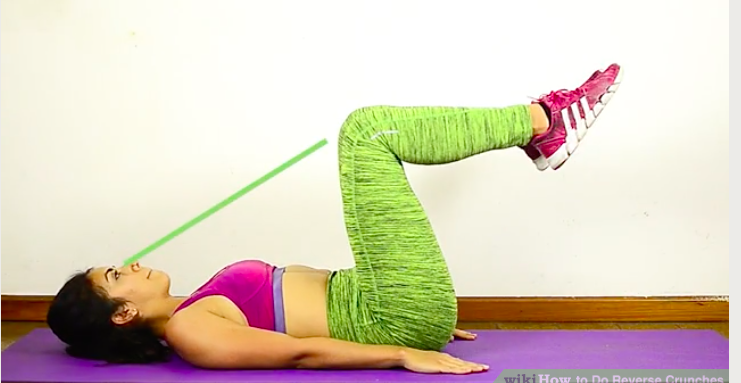Analysis by Dr Paul Batman PhD
Client Instruction
 Starting Position
Starting Position
- Lie is a supine position with your knees bent and your heels close to your bottom
- Place your arms by the side of your body and in contact with the floor
Up Phase
- From this starting position slowly tilt your pelvis back towards your chest by raising your bottom off the floor
- Continue to bring your knees towards your chest by contracting your abdominals to curl your spine
Down Phase
- Pause in this position and then slowly lower your heels back to the floor
Muscle Analysis
Up Phase
Joint Action Contraction Muscle Group
Spinal Joint Flexion Concentric Spinal Joint Flexors
Down Phase
In the down phase of the exercise the body is lowered slowly with gravity. The same muscles that concentrically contracted to lift the body are those that are eccentrically contracting to lower the body.
General Kinesiological Analysis
In a reverse crunch the spinal joint is flexed by the concentric contraction of the rectus abdominis, external obliques and the internal obliques.
Advanced Kinesiological Analysis
The prime movers of the reverse crunch are the rectus abdominis, external obliques and the internal oblique. As this muscles contract concentrically they neutralise any unwanted spinal rotation, lateral flexion or lateral tilt of the pelvis.
The abdominal muscles are contracting in spinal flexion in this exercise as a consequence of the pelvis moving into backward tilt. The sacrum is the last vertebral area that is in contact with the pelvic bone on either side of the pelvis. When the hip is forced into flexion, the pelvis must follow into backward tilt, which will then cause the spine to flex.
The reverse crunch has been modified to increase the degree of difficulty by performing it on an incline board. This forces the backward tilt of the pelvis and the spine to flex against the increasing pull of gravity.
Studies have supported the notion that the backward tilt movement is caused more by the fibres of the lower rectus abdominis than the upper fibres of the same muscle.
The concept of the backward tilt of the pelvis has been used in many pelvic tilting exercises. Clients can lie in a straight lying supine position on the floor and pull through their belly by tilting their pelvis back and flattening their spine into the floor. This movement will force the spinal flexors to contract both concentrically and statically without any accompanying hip flexors contracting.
Clients can sit on a stability ball in an upright position with their knees at a 90degrees angle. In this position they can roll their pelvis back and forth by moving the ball that they are sitting on, which forces the pelvis into both forward and backward tilt, contracting both the abdominals and the erector spinae.
A more advanced exercise that follows the same pattern as backward tilting of the pelvis, is the hanging bent leg raise. This is performed with the client hanging from a bar or supporting their body weight on a hip flexion machine. From this starting position the client attempts to bring their bent knees up to the chest without swinging the legs. As the hip joint flexors are contracting concentrically the pelvis is initially stabilized by the static contraction of the rectus abdominis, external oblique, the internal oblique and the erector spinae muscles. When the hip extends beyond 90 degrees of hip joint flexion, the pelvis must now move into backward tilt by the concentric concentration of the rectus abdominis, external obliques and the internal obliques. As the pelvis moves into backward tilt, the spine will flex. In the event that this exercise is prescribed to clients with abdominal strength it is sometimes apparent that the psoas paradox is activated. As the hip joint flexors contract to cause hip joint flexion the abdominals are too weak to stabilize the spine and the spine will be forced to hyperextend or arch. This indicates that the hip joint flexors are contracting to cause hip joint flexion and at the same time are responsible for spinal joint hyperextension.
Occasionally the hanging leg raise is completed with the knees in extension. This increases the lever length of the lower leg, placing greater emphasis on the concentric contraction of the hip joint flexors. Because of the stretching of the hamstrings it is very difficult to lift he knees towards the chest. Most clients will only be able to lift the hips to 90 degrees of hip flexion. The abdominals must statically contract with great force to prevent the spine from hyper-extending. It is very difficult for the abdominals to contract concentrically to cause the pelvis to move into backward tilt.
